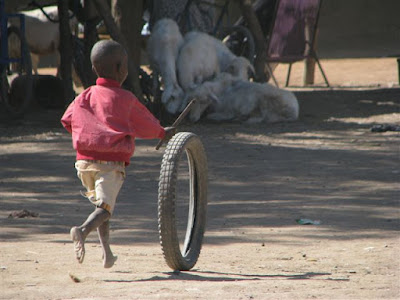Since the great rush by Europeans to take anything that wasn't bolted down from Africa to make a profit (including people) began, back when the vast majority of West Africa was clumped under the rather uninspired name of "Negroland" (the more lucrative areas along the Ghana - Cote d'Ivoire coasts getting the flashier name of "The Gold Coast"), the area along the Niger River controlled by the Bambarra and Songhai - now known as Mali - has been held in almost mystical regard by European explorers.
I found this rather interesting "new and accurate map of Negroland" (1747) showing the European colonies along the coast and the main tribal regions (and, of course, what resources the Europeans could get [read: take] out of them).

(click on the map for a larger version)
Of note is the question that plagued explorers for over a century, as described in the 1840 book The Life and Times of Mungo Park :
"Few subjects have excited a more lively interest among the curious and the learned, than the geographical problem with regard to the termination of the Niger... This question was eventually put at rest, but not until more than half a century of fruitless effort and speculation, during which many valuable lives had been sacrificed in attempting to trace to it's outlet the course of the mysterious river."
The map depicts the theory of the day that had the gamibia river orginating in Mali and another river flowing from Lybia to a great desert lake near timbuktu. The actual outlet of the Niger in Nigeria's oil rich delta came from a diferent river all together. It seemed impossible that a river would flow out of the foothills and lush lanscape of what is now The Gambia and eastern Senegal, through Mali towards the Sahara before heading south though Niger and Nigeria to empty into the Bight of Benin. In fact, when Mungo park first set out to Mali, he had no idea which way the niger flowed despite his claim to sail down river to it's terminus...
It is this rather perculiar course that lead the river to be a major highway between Mali and downstream countries such as Niger and Nigeria. Thus trading ports such as timbuktu could flourish, bring salt from the mines tio the north in exchange for gold and the like from the south.
This is shown in the description of the kingdom of Tombut [Timbuktu]"from whence are brought gold, ivory and good tin."
Timbuctoo, Tumbuto, Tombouctou, Tumbyktu, Timbuktu or Tembuch (It doesn't seem to matter how you spell it) has been claiming European victims, and luring many to their deaths, since it first appeared (as Tembuch) on a Catalan map of the fourteenth century.
Rumour had been spreading of a mystical almost "el doardo"-like city in the Sahara that was abundant with gold and other such wealth that could be plundered by Europe... if only they could find it.
Timbuktu was first visited by a modern European in 1826, when the Scottish explorer Maj. Gordon Laing made it across the desert, only to be murdered soon after by the locals for refusing to convert to Islam... The African Association had been founded in Britain with the determination that a Brit should be the first European to set foot in Timbuctoo. And so he did. of course, he did not return...
The fervor was fanned by the likes of Chapman who wrote:
Deep in that lion-haunted inland lies
A mystic city, goal of high enterprise
..and a young Tennyson (before he was a lord) got very wordy with his poem "Timbuctoo". Rightly, as it would later be revealed, he wrote:
Or is the rumour of thy Timbuctoo
A dream as frail as those of ancient time?
A few years later the French announced that a Monsieur René Caillié had reached the lost city, dressed as a poor Arab, and returned alive. His description of the city somewhat deflated the myth:
"I had formed a totally different idea of the grandeur and wealth of Timbuctoo... The city presented, at first sight, nothing but a mass of ill-looking houses, built of earth. Nothing was to be seen in all directions, but immense quicksands of a yellowish white colour ... the most profound silence prevailed."
This is the Timbuktu that one meets today after long voyage up the river Niger.
The air of mystery may have evaporated from Timbuktu under the sun and shifting sands of the Sahara, but the Country of Mali still has a lot to offer.
A former French colony, Mali still receives daily flights Paris and Marseilles, french is spoken widely and although there has been much western influence since independence and tourism is starting to flourish, the country offers a fresh, almost naive, face of west Africa - Africa for Beginners, as it were...
Unlike the hustle and bustle of coastal West Africa or the stricter, often conflict ridden areas ruled by Sharia Law, Mali is a laid-back, more relaxed, "Muslim-lite" (as one local described it) part of the world. One which George, Todd and I grew to love over two weeks travelling around...

 Cheers!
Cheers!
 Pam's beach hut was a bit of a hike - a good hour from lagos through the lagoons. But it was worth it!! It was beautiful. Unfortunately they'd lost at least 50m of beach during the wet season (making the narrow peninsula only brely 100m wide where the hut is...) But as it was harmattan you could still swim.
Pam's beach hut was a bit of a hike - a good hour from lagos through the lagoons. But it was worth it!! It was beautiful. Unfortunately they'd lost at least 50m of beach during the wet season (making the narrow peninsula only brely 100m wide where the hut is...) But as it was harmattan you could still swim. 


















































